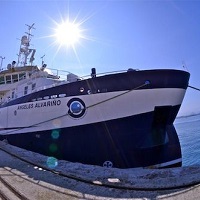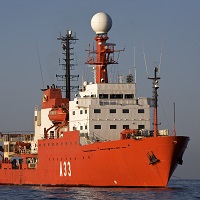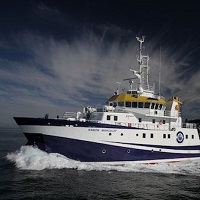Contact for the resource
Barcelona University (UB), Department of Stratigraphy, Paleontology and Marine Geosciences
12 record(s)
Type of resources
Categories
Topics
INSPIRE themes
Keywords
Contact for the resource
Provided by
Years
Formats
Status
-

The main target of the NUREIEVA-MAR-1 campaign is twofold. On the one hand, it aims to establish the geometry and the three-dimensional internal structure of the deposit of mineral discharges submerged in front of the Bay of Portmán and, on the other hand, it intends to verify the data obtained by obtaining witnesses from the deposit. During the campaign, a high resolution multibeam bathymetric cartography and a high density mesh of TOPAS PS18 parametric probe profiles will be carried out, and sediment tokens will be obtained by gravity or piston core grabs of the longest length possible, as well as by means of multicorer, box corer and dredge Van Veen for the upper part of the deposit. In addition, the discharge of dissolved metals from the deposit emerged at sea will be quantified using CTD profiles and sampling with hydrographic bottles. Floating microplastics will also be sampled.
-

The objectives of the DETSUFA cruise (BIO Hespérides 04/03–17/03/2013) are (1) to evaluate the footprint in the seafloor of a series of earthquake-generated subaerial landslides that took place in Fiordo de Aysén, Chile, in 2007, which entered the seawater generating a number of destructive tsunamis which killed 10 and produced significant damage in the local infrastructure, (2) to reconstruct the morphology and dynamics of these landslides in order to obtain input data for tsunami modelling, and (3) to determine the occurrence of similar episodes in the past that might have generated other tsunamis, in order to establish a possible recurrence period of such events. The cruise fits within the global scientific interest stirred up by tsunamis in general, being the Fiordo de Aysén a highly relevant analogue for the understanding of this kind of events occurring in semi-enclosed basins such as fjords, lakes or water dams, which often harbour large human population and infrastructures.
-

Estudio oceanografico multidisciplar del Mar Catalano-Balear
-

The objective of the DOS MARES project is twofold. First, we aim at understanding the effects of the atmospheric teleconnections between the Cantabrian Sea and the north-western Mediterranean Sea, and their impacts on the deep ecosystem, both pelagic and benthic. Second, we want to know in which way the transfer of the signal from the external forcings towards the deep ecosystem controls the community structure and the population dynamics. Thus, in March 2012 we deployed 6 mooring lines equipped with sediment traps and currentmeters in the Avilés and Gaviera canyons and the slope. In September 2012 the moorings were successfully recovered and redeployed again, and during this cruise DOSMARES BIOCANT3 they have been finally recovered and the 1-year monitoring effort finalised. In addition, CTD profiling has been performed to characterise the biological and physical structure of the water column (including the acquisition of discrete water samples), multicorers have been obtained to characterise the geochemical properties of surface sediments, and a multinet used to obtain macro- and meso-zooplankton community structure. Overall, data will allow to characterize the external forcings and abiotic conditions in the Cantabrian Sea, and thus establish the links between abiotic conditions, populations and pelagic and benthopelagic resources.
-
NA
-

In this cruise the mooring lines deployed in April 2012 have been recovered. In addition communication between acoustic receivers and a deck unit has been tested. This is part of the international program OTN ("Ocean Tracking Network," in Spanish "Red de Seguimiento Oceánico"). This work is preparatory for the deployment of a curtain listening across the Strait of Gibraltar.
-

Training of students of the Master of Marine Sciences: Oceanography and Marine Environment Management of the University of Barcelona.
-
SURVEY OF THE WHOLE STUDY AREA OF THE MTP SUBPROJECT EUROMARGE-NORTH WESTERN MEDITERRANEAN, FOCUSED TOWARDS MEASUREMENTS AND SAMPLES FOR OCEANOGRAPHICAL BIOGECHEMICAL PARAMETERS, WITH SPECIAL ATTENTION TO FOUR SITES LOCATED ALONG THE LIGURO-PROVENCAL-CATALAN CURRENT
-
The overall objective of the cruise was to identify the pathways of sediment transfer from the conjugate margins of Algeria and of the Balearic Promontory to the Algerian Basin from the Early Pliocene flooding of the Mediterranean to the Present.The cruise is the result of a co-operation between the University of Barcelona and OGS within HERMES (Hotspot Ecosystems Research on the Margins of European Seas) Integrated Project.The proposed research complies also with the objectives of the Collaborative Research Programme ESF-EUROCORES on EUROMARGINS 'WEST-MED' and 'SPACOMA'. The survey has been planned in order to fill the bathymetry among existing data sets:- Spanish EEZ project (Instituto Espa?ol de Oceanografia and Instituto Hidrografico de la Marina);- The BALCOM Project (Instituto Espa?ol de Oceanografia);- And the MARADJA Project (Universite de Bretagne Occidentale and IFREMER).In addition the survey area covers the track of multichannel seismic profile MS-46 acquired by OGS in 1972.The cruise went very smoothly, helped by excellent weather conditions and proper functioning of the instrumentation. Departure from Palma on Sep 20 15:50. Begin of multibeam and chirp sonar survey the same day at 20:00. Start of multichannel seismic survey on Sep 27 at 17:45. End of operations on Sep 29 at 24:00. Arrival in Cartagena on Sep 30 at 12:00.
-

The leg 1 of the NUREIEV 3 oceanographic cruise took place from 22 to 30 April 2016. The area of work has located on the continental margin of the SE of Iberian Peninsula, off the coast of Murcia and Almeria, with reference coordinates from 36º20'N to 37º36'N and 2º40'W to 0º40'W. The tasks performed consisted of: • Bathymetric mapping with multibeam echosounder for seabed mapping, from inner shelf to upper slope (50 to 1500 m depth). • Geophysical works with TOPAS, very high resolution seismic profiles, to characterize the sedimentary cover of the study area. • Recovery of 5 mooring lines, instrumented for the continuous monitoring of the hydrological (water masses) and sediment (particle fluxes) dynamics from the last cruise in September 2015. Each mooring line is composed by one current meter for measuring temperature, turbidity, velocity and direction of currents and one sediment trap for sampling sinking particles. In addition, each mooring is equipped with an acoustic release for recovery and with suitable buoyancy. Monitoring with instrumented mooring lines has covered an annual cycle, in two phases of 6 months each one. • CTD profiling and water sampling. Profiles have been made in each of the submarine canyons monitored for measuring physical and chemical variables of water column (temperature, salinity, turbidity, oxygen concentration and chlorophyll) and calibration of instruments of mooring lines. • Performing surface sampling of floating microplastics by neuston net. • Sampling of surface sediments by multicorer.
 Catálogo de datos del IEO
Catálogo de datos del IEO